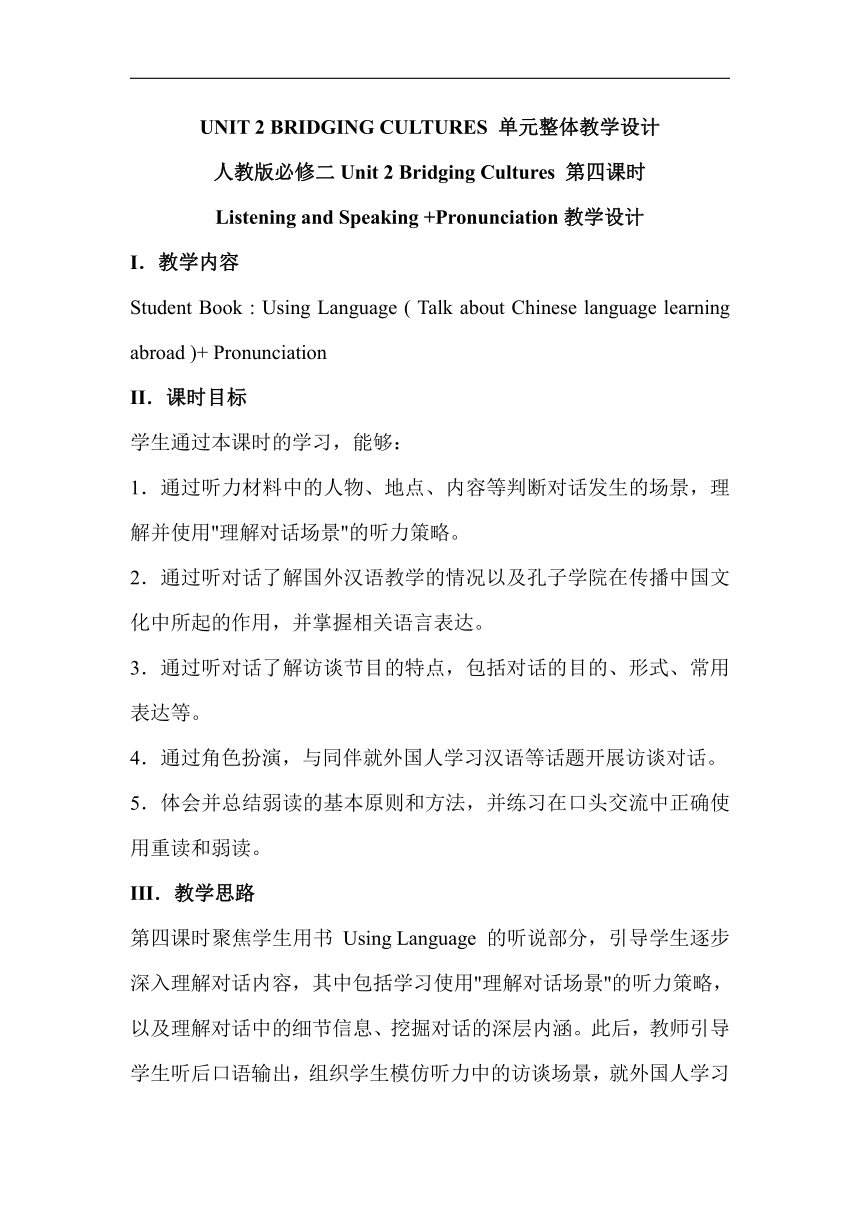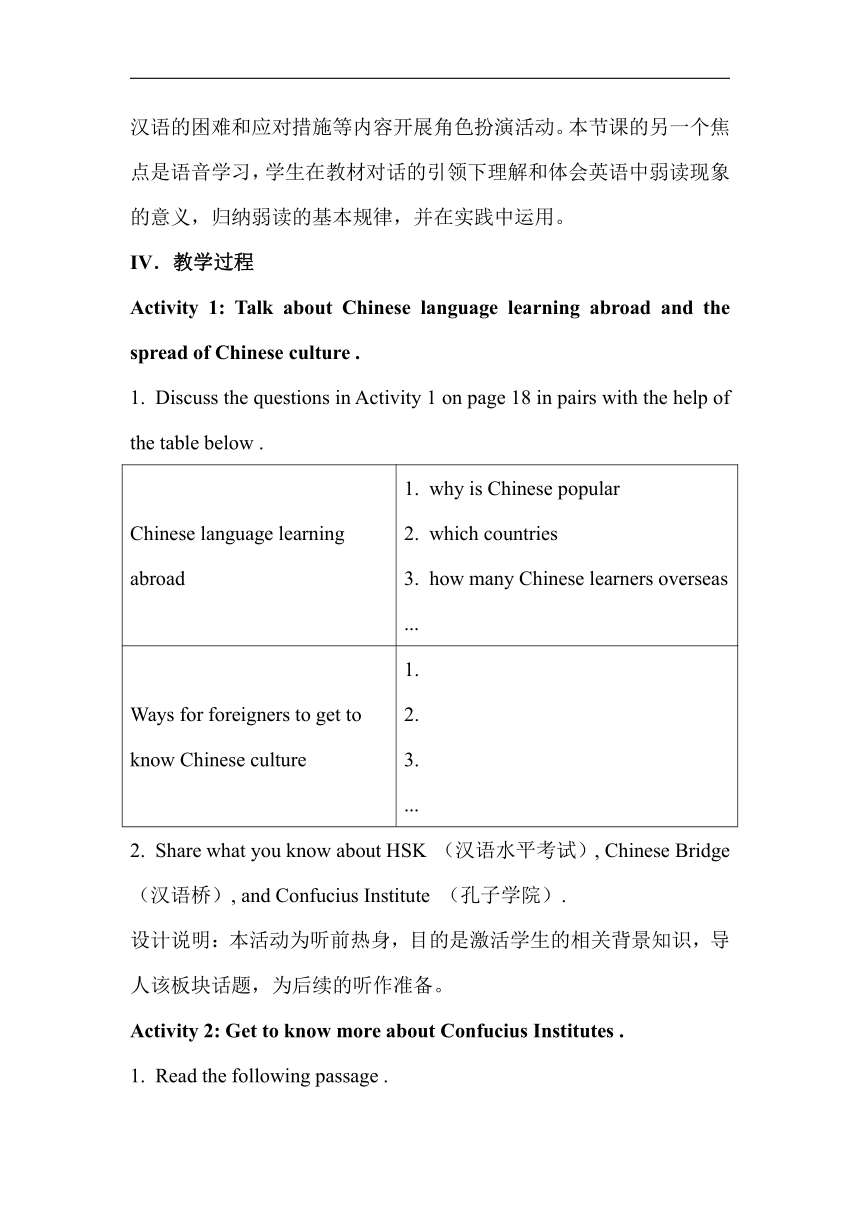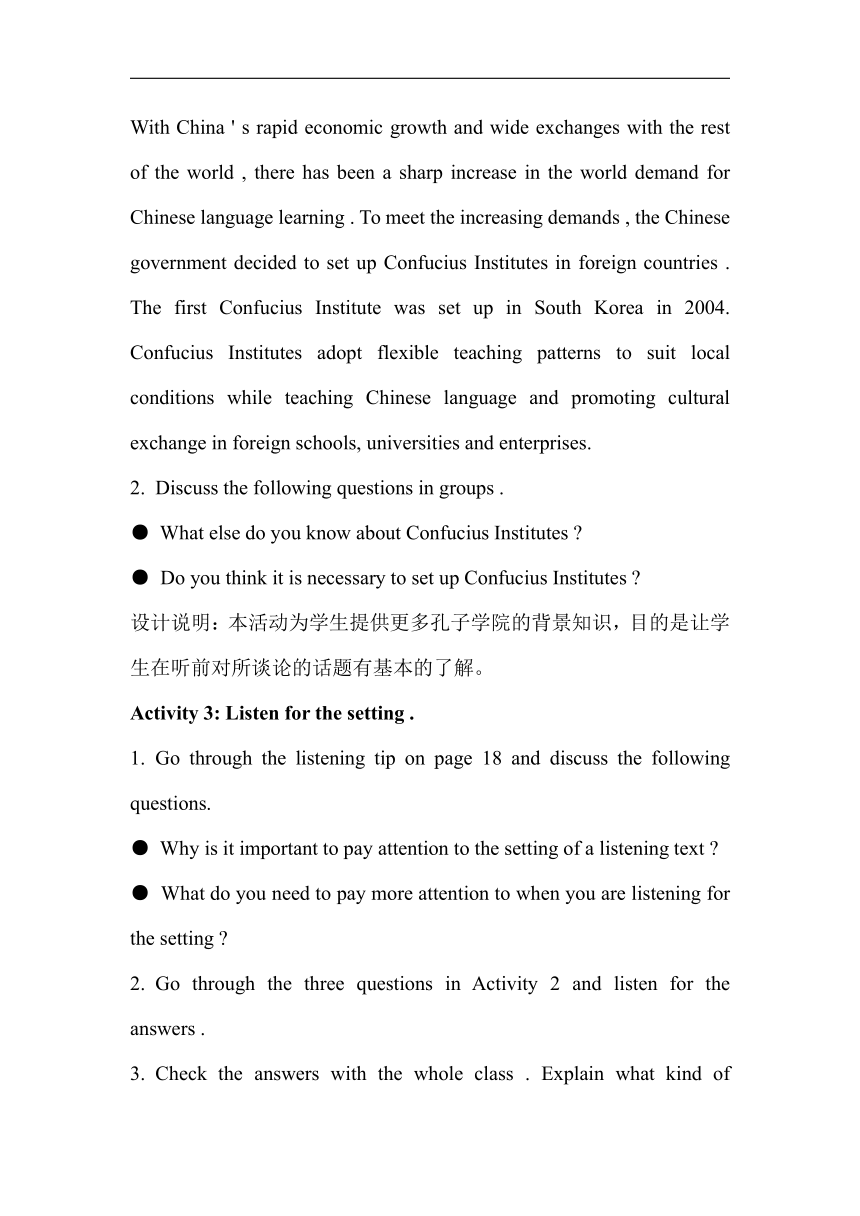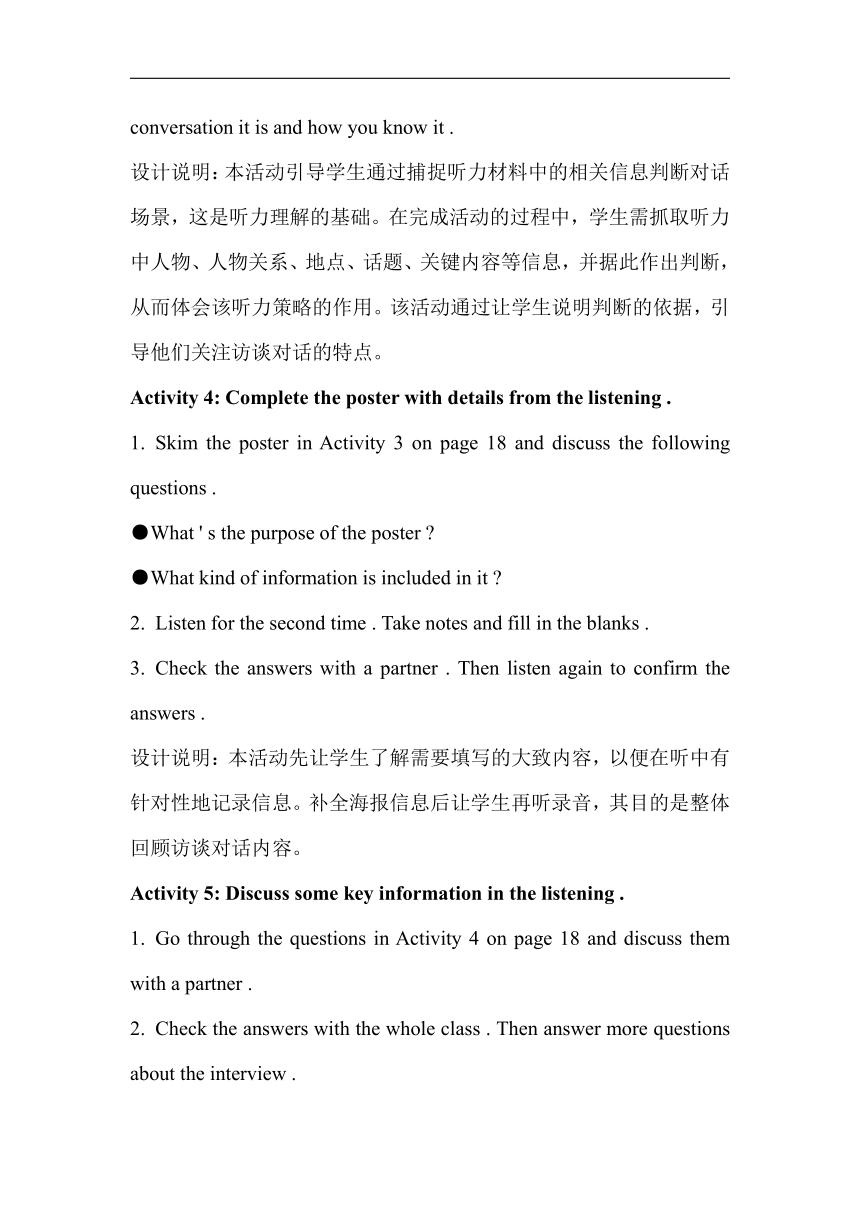人教版(2019)选择性必修第二册Unit 2 Bridging Cultures Listening and Speaking Pronunciation 教学设计
文档属性
| 名称 | 人教版(2019)选择性必修第二册Unit 2 Bridging Cultures Listening and Speaking Pronunciation 教学设计 |

|
|
| 格式 | docx | ||
| 文件大小 | 21.3KB | ||
| 资源类型 | 教案 | ||
| 版本资源 | 人教版(2019) | ||
| 科目 | 英语 | ||
| 更新时间 | 2024-04-14 17:30:58 | ||
图片预览




文档简介
UNIT 2 BRIDGING CULTURES 单元整体教学设计
人教版必修二Unit 2 Bridging Cultures 第四课时
Listening and Speaking +Pronunciation教学设计
I.教学内容
Student Book : Using Language ( Talk about Chinese language learning abroad )+ Pronunciation
II.课时目标
学生通过本课时的学习,能够:
通过听力材料中的人物、地点、内容等判断对话发生的场景,理解并使用"理解对话场景"的听力策略。
通过听对话了解国外汉语教学的情况以及孔子学院在传播中国文化中所起的作用,并掌握相关语言表达。
通过听对话了解访谈节目的特点,包括对话的目的、形式、常用表达等。
通过角色扮演,与同伴就外国人学习汉语等话题开展访谈对话。
体会并总结弱读的基本原则和方法,并练习在口头交流中正确使用重读和弱读。
III.教学思路
第四课时聚焦学生用书 Using Language 的听说部分,引导学生逐步深入理解对话内容,其中包括学习使用"理解对话场景"的听力策略,以及理解对话中的细节信息、挖掘对话的深层内涵。此后,教师引导学生听后口语输出,组织学生模仿听力中的访谈场景,就外国人学习汉语的困难和应对措施等内容开展角色扮演活动。本节课的另一个焦点是语音学习,学生在教材对话的引领下理解和体会英语中弱读现象的意义,归纳弱读的基本规律,并在实践中运用。
IV.教学过程
Activity 1: Talk about Chinese language learning abroad and the spread of Chinese culture .
Discuss the questions in Activity 1 on page 18 in pairs with the help of the table below .
Chinese language learning abroad why is Chinese popular which countries how many Chinese learners overseas ...
Ways for foreigners to get to know Chinese culture 1. 2. 3. ...
Share what you know about HSK (汉语水平考试), Chinese Bridge (汉语桥), and Confucius Institute (孔子学院).
设计说明:本活动为听前热身,目的是激活学生的相关背景知识,导人该板块话题,为后续的听作准备。
Activity 2: Get to know more about Confucius Institutes .
Read the following passage .
With China ' s rapid economic growth and wide exchanges with the rest of the world , there has been a sharp increase in the world demand for Chinese language learning . To meet the increasing demands , the Chinese government decided to set up Confucius Institutes in foreign countries . The first Confucius Institute was set up in South Korea in 2004. Confucius Institutes adopt flexible teaching patterns to suit local conditions while teaching Chinese language and promoting cultural exchange in foreign schools, universities and enterprises.
Discuss the following questions in groups .
● What else do you know about Confucius Institutes
● Do you think it is necessary to set up Confucius Institutes
设计说明:本活动为学生提供更多孔子学院的背景知识,目的是让学生在听前对所谈论的话题有基本的了解。
Activity 3: Listen for the setting .
Go through the listening tip on page 18 and discuss the following questions.
● Why is it important to pay attention to the setting of a listening text
● What do you need to pay more attention to when you are listening for the setting
Go through the three questions in Activity 2 and listen for the answers .
Check the answers with the whole class . Explain what kind of conversation it is and how you know it .
设计说明:本活动引导学生通过捕捉听力材料中的相关信息判断对话场景,这是听力理解的基础。在完成活动的过程中,学生需抓取听力中人物、人物关系、地点、话题、关键内容等信息,并据此作出判断,从而体会该听力策略的作用。该活动通过让学生说明判断的依据,引导他们关注访谈对话的特点。
Activity 4: Complete the poster with details from the listening .
Skim the poster in Activity 3 on page 18 and discuss the following questions .
●What ' s the purpose of the poster
●What kind of information is included in it
Listen for the second time . Take notes and fill in the blanks .
Check the answers with a partner . Then listen again to confirm the answers .
设计说明:本活动先让学生了解需要填写的大致内容,以便在听中有针对性地记录信息。补全海报信息后让学生再听录音,其目的是整体回顾访谈对话内容。
Activity 5: Discuss some key information in the listening .
Go through the questions in Activity 4 on page 18 and discuss them with a partner .
Check the answers with the whole class . Then answer more questions about the interview .
●According to Ms Hu , what brings the world together Do you agree with her Why or why not
●How does Aisha Khan think we should bring the world together
●What can you do to bridge cultures around the world
设计说明:本活动引导学生深入讨论访谈内容,并进一步挖掘其主题内涵。上述问题有助于培养学生的思维能力,帮助他们深化对本单元主题的认识。
Activity 6: Role - play.
Work in groups of four : One acts as the interviewer and the other three as the students from Confucius Institutes . The interviewer interviews the students about their experience of learning Chinese language and their experience with Chinese culture .
Practise the interview within your group .
Present your interview before the whole class .
The interviewer of each group gives a report of the interview before the whole class .
设计说明:该活动由教材中的口语活动改编而来,参与人数的增加以及采访内容的扩展有利于激发学生的积极性和创造性。另外,本活动增加了汇报环节,意在训练学生的转述能力。
Activity 7: Understand the use of weak forms.
Skim the conversation in Activity 1 on page 19 and answer the three questions .
Read for the second time and answer the following questions .
●Why did Miss Conner say " English is a stress - based language "
●What kinds of words are not stressed ( Pronouns , articles , prepositions , and conjunctions .) And what are stressed ( Nouns , verbs , adjectives , adverbs , numerals , and interjections .)
●How do we say these unstressed words when we speak
●Why is it useful to watch English movies
设计说明:本活动帮助学生读懂对话内容,理解对话中聚焦的语音现象,以及英语中弱读的基本原则、训练方法和重要性。
Activity 8: Summarise the use of weak forms .
Read these sentences with a partner and decide which words should be stressed and which should not .
●The streets are wide and clean .
●Show us the picture that you have drawn .
●Last but not least , treasure the time .
●Can I have some tea with ice and lemon
●I ' ve told him to keep away from her .
Summarise the words which are usually not stressed with the help of the table below . Add more words to the list and look them up in a dictionary if necessary .
词性 例词 强读式 弱读式 词性 例词 强读式 弱读式
冠词 a an the ... 不定代词 some many any ...
介词 to of for ... be 动词 be are was ...
连词 as so but ... 助动词 do has had ...
人称代词 you us them ... 情态动词 can should must ...
设计说明:本活动引导学生总结常见的弱读单词,对比它们的强读发音和弱读发音,帮助学生掌握常见弱读单词的发音。
Activity9:Practise weak forms with the conversation.
1.Read the conversation in Activity 1 on page 19 aloud . Mark the words that are not stressed and then listen to the recording to check .
2.Practise the conversation with a partner .
设计说明:本活动让学生在掌握弱读基本原则和技巧的基础上,进一步体会弱读的使用,并学会正确把握句子中的重读和弱读单词,进而提升语音语调的准确性和流畅性。
Assignment
Read the listening script about the interview with Aisha Khan after the recording . Underline the words and expressions that are important to you in the script . Suppose you are the interviewer . Write a news report based on the script .
设计说明:课后作业再次利用听力文本,让学生将采访对话改写成新闻报道,实现从听到写的转化。学生需要关注单词的拼写、语法的准确性和篇章的连贯性等方面,从而进一步提升语言技能。
人教版必修二Unit 2 Bridging Cultures 第四课时
Listening and Speaking +Pronunciation教学设计
I.教学内容
Student Book : Using Language ( Talk about Chinese language learning abroad )+ Pronunciation
II.课时目标
学生通过本课时的学习,能够:
通过听力材料中的人物、地点、内容等判断对话发生的场景,理解并使用"理解对话场景"的听力策略。
通过听对话了解国外汉语教学的情况以及孔子学院在传播中国文化中所起的作用,并掌握相关语言表达。
通过听对话了解访谈节目的特点,包括对话的目的、形式、常用表达等。
通过角色扮演,与同伴就外国人学习汉语等话题开展访谈对话。
体会并总结弱读的基本原则和方法,并练习在口头交流中正确使用重读和弱读。
III.教学思路
第四课时聚焦学生用书 Using Language 的听说部分,引导学生逐步深入理解对话内容,其中包括学习使用"理解对话场景"的听力策略,以及理解对话中的细节信息、挖掘对话的深层内涵。此后,教师引导学生听后口语输出,组织学生模仿听力中的访谈场景,就外国人学习汉语的困难和应对措施等内容开展角色扮演活动。本节课的另一个焦点是语音学习,学生在教材对话的引领下理解和体会英语中弱读现象的意义,归纳弱读的基本规律,并在实践中运用。
IV.教学过程
Activity 1: Talk about Chinese language learning abroad and the spread of Chinese culture .
Discuss the questions in Activity 1 on page 18 in pairs with the help of the table below .
Chinese language learning abroad why is Chinese popular which countries how many Chinese learners overseas ...
Ways for foreigners to get to know Chinese culture 1. 2. 3. ...
Share what you know about HSK (汉语水平考试), Chinese Bridge (汉语桥), and Confucius Institute (孔子学院).
设计说明:本活动为听前热身,目的是激活学生的相关背景知识,导人该板块话题,为后续的听作准备。
Activity 2: Get to know more about Confucius Institutes .
Read the following passage .
With China ' s rapid economic growth and wide exchanges with the rest of the world , there has been a sharp increase in the world demand for Chinese language learning . To meet the increasing demands , the Chinese government decided to set up Confucius Institutes in foreign countries . The first Confucius Institute was set up in South Korea in 2004. Confucius Institutes adopt flexible teaching patterns to suit local conditions while teaching Chinese language and promoting cultural exchange in foreign schools, universities and enterprises.
Discuss the following questions in groups .
● What else do you know about Confucius Institutes
● Do you think it is necessary to set up Confucius Institutes
设计说明:本活动为学生提供更多孔子学院的背景知识,目的是让学生在听前对所谈论的话题有基本的了解。
Activity 3: Listen for the setting .
Go through the listening tip on page 18 and discuss the following questions.
● Why is it important to pay attention to the setting of a listening text
● What do you need to pay more attention to when you are listening for the setting
Go through the three questions in Activity 2 and listen for the answers .
Check the answers with the whole class . Explain what kind of conversation it is and how you know it .
设计说明:本活动引导学生通过捕捉听力材料中的相关信息判断对话场景,这是听力理解的基础。在完成活动的过程中,学生需抓取听力中人物、人物关系、地点、话题、关键内容等信息,并据此作出判断,从而体会该听力策略的作用。该活动通过让学生说明判断的依据,引导他们关注访谈对话的特点。
Activity 4: Complete the poster with details from the listening .
Skim the poster in Activity 3 on page 18 and discuss the following questions .
●What ' s the purpose of the poster
●What kind of information is included in it
Listen for the second time . Take notes and fill in the blanks .
Check the answers with a partner . Then listen again to confirm the answers .
设计说明:本活动先让学生了解需要填写的大致内容,以便在听中有针对性地记录信息。补全海报信息后让学生再听录音,其目的是整体回顾访谈对话内容。
Activity 5: Discuss some key information in the listening .
Go through the questions in Activity 4 on page 18 and discuss them with a partner .
Check the answers with the whole class . Then answer more questions about the interview .
●According to Ms Hu , what brings the world together Do you agree with her Why or why not
●How does Aisha Khan think we should bring the world together
●What can you do to bridge cultures around the world
设计说明:本活动引导学生深入讨论访谈内容,并进一步挖掘其主题内涵。上述问题有助于培养学生的思维能力,帮助他们深化对本单元主题的认识。
Activity 6: Role - play.
Work in groups of four : One acts as the interviewer and the other three as the students from Confucius Institutes . The interviewer interviews the students about their experience of learning Chinese language and their experience with Chinese culture .
Practise the interview within your group .
Present your interview before the whole class .
The interviewer of each group gives a report of the interview before the whole class .
设计说明:该活动由教材中的口语活动改编而来,参与人数的增加以及采访内容的扩展有利于激发学生的积极性和创造性。另外,本活动增加了汇报环节,意在训练学生的转述能力。
Activity 7: Understand the use of weak forms.
Skim the conversation in Activity 1 on page 19 and answer the three questions .
Read for the second time and answer the following questions .
●Why did Miss Conner say " English is a stress - based language "
●What kinds of words are not stressed ( Pronouns , articles , prepositions , and conjunctions .) And what are stressed ( Nouns , verbs , adjectives , adverbs , numerals , and interjections .)
●How do we say these unstressed words when we speak
●Why is it useful to watch English movies
设计说明:本活动帮助学生读懂对话内容,理解对话中聚焦的语音现象,以及英语中弱读的基本原则、训练方法和重要性。
Activity 8: Summarise the use of weak forms .
Read these sentences with a partner and decide which words should be stressed and which should not .
●The streets are wide and clean .
●Show us the picture that you have drawn .
●Last but not least , treasure the time .
●Can I have some tea with ice and lemon
●I ' ve told him to keep away from her .
Summarise the words which are usually not stressed with the help of the table below . Add more words to the list and look them up in a dictionary if necessary .
词性 例词 强读式 弱读式 词性 例词 强读式 弱读式
冠词 a an the ... 不定代词 some many any ...
介词 to of for ... be 动词 be are was ...
连词 as so but ... 助动词 do has had ...
人称代词 you us them ... 情态动词 can should must ...
设计说明:本活动引导学生总结常见的弱读单词,对比它们的强读发音和弱读发音,帮助学生掌握常见弱读单词的发音。
Activity9:Practise weak forms with the conversation.
1.Read the conversation in Activity 1 on page 19 aloud . Mark the words that are not stressed and then listen to the recording to check .
2.Practise the conversation with a partner .
设计说明:本活动让学生在掌握弱读基本原则和技巧的基础上,进一步体会弱读的使用,并学会正确把握句子中的重读和弱读单词,进而提升语音语调的准确性和流畅性。
Assignment
Read the listening script about the interview with Aisha Khan after the recording . Underline the words and expressions that are important to you in the script . Suppose you are the interviewer . Write a news report based on the script .
设计说明:课后作业再次利用听力文本,让学生将采访对话改写成新闻报道,实现从听到写的转化。学生需要关注单词的拼写、语法的准确性和篇章的连贯性等方面,从而进一步提升语言技能。
